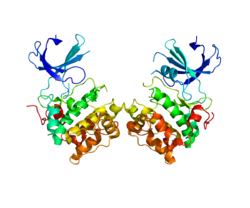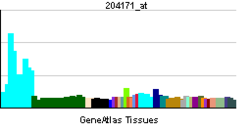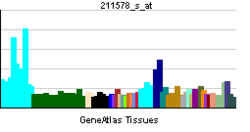- P70-S6 Kinase 1
-
Ribosomal protein S6 kinase beta-1 is an enzyme that in humans is encoded by the RPS6KB1 gene.[1][2]
This gene encodes a member of the RSK (ribosomal s6 kinase) family of serine/threonine kinases. This kinase contains 2 non-identical kinase catalytic domains and phosphorylates several residues of the S6 ribosomal protein. The kinase activity of this protein leads to an increase in protein synthesis and cell proliferation. According to a May 2010 online news release by the Cincinnati Cancer Consortium with the Academic Health Center of the University of Cincinnati, inhibition of the S6K1 protein, or a lack of it, slows the production of adipose (fat) cells by disrupting and retarding the initial "commitment stage" of their formation. The study could have implications for the treatment of obesity.[3] Amplification of the region of DNA encoding this gene and overexpression of this kinase are seen in some breast cancer cell lines. Another pathway for which P70 has proposed involvement is in muscle lengthening and growing. An ongoing study at the Medical College of Wisconsin has demonstrated that P70 is phosphorolated by passive stretch in the soleus muscle. This may be one of many protein kinases involved in muscle building. Alternative translational start sites have been described and alternative transcriptional splice variants have been observed but have not been thoroughly characterized.[2]
Interactions
P70-S6 Kinase 1 has been shown to interact with CSNK2B,[4] EIF3B,[5] COASY,[6] KIAA1303,[7][8][9][10] POLDIP3,[11] Mammalian target of rapamycin,[12][13][14][15][16][17][18][19][20][21][22][23] PPP2R2A,[24][25] RBX1[26] and Ubiquitin C.[26]
References
- ^ Grove JR, Banerjee P, Balasubramanyam A, Coffer PJ, Price DJ, Avruch J, Woodgett JR (1991). "Cloning and expression of two human p70 S6 kinase polypeptides differing only at their amino termini". Mol Cell Biol 11 (11): 5541–50. PMC 361924. PMID 1922062. http://www.pubmedcentral.nih.gov/articlerender.fcgi?tool=pmcentrez&artid=361924.
- ^ a b "Entrez Gene: RPS6KB1 ribosomal protein S6 kinase, 70kDa, polypeptide 1". http://www.ncbi.nlm.nih.gov/sites/entrez?Db=gene&Cmd=ShowDetailView&TermToSearch=6198.
- ^ Carnevalli, L; NCarnevalli LS, Masuda K, Frigerio F, Le Bacquer O, Um SH, Gandin V, Topisirovic I, Sonenberg N, Thomas G, Kozma SC (2010). "S6K1 Plays a Critical Role in Early Adipocyte Differentiation". Dev Cell 18 (5): 763–74. doi:10.1016/j.devcel.2010.02.018. PMC 2918254. PMID 20493810. http://www.pubmedcentral.nih.gov/articlerender.fcgi?tool=pmcentrez&artid=2918254.
- ^ Panasyuk, Ganna; Nemazanyy Ivan, Zhyvoloup Alexander, Bretner Maria, Litchfield David W, Filonenko Valeriy, Gout Ivan T (2006). "Nuclear export of S6K1 II is regulated by protein kinase CK2 phosphorylation at Ser-17". J. Biol. Chem. 281 (42): 31188–201. doi:10.1074/jbc.M602618200. PMID 16895915.
- ^ Holz, Marina K; Ballif Bryan A, Gygi Steven P, Blenis John (2005). "mTOR and S6K1 mediate assembly of the translation preinitiation complex through dynamic protein interchange and ordered phosphorylation events". Cell 123 (4): 569–80. doi:10.1016/j.cell.2005.10.024. PMID 16286006.
- ^ Nemazanyy, Ivan; Panasyuk Ganna, Zhyvoloup Alexander, Panayotou George, Gout Ivan T, Filonenko Valeriy (2004). "Specific interaction between S6K1 and CoA synthase: a potential link between the mTOR/S6K pathway, CoA biosynthesis and energy metabolism". FEBS Lett. 578 (3): 357–62. doi:10.1016/j.febslet.2004.10.091. PMID 15589845.
- ^ Ali, Siraj M; Sabatini David M (2005). "Structure of S6 kinase 1 determines whether raptor-mTOR or rictor-mTOR phosphorylates its hydrophobic motif site". J. Biol. Chem. 280 (20): 19445–8. doi:10.1074/jbc.C500125200. PMID 15809305.
- ^ Ha, Sang Hoon; Kim Do-Hyung, Kim Il-Shin, Kim Jung Hwan, Lee Mi Nam, Lee Hyun Ju, Kim Jong Heon, Jang Sung Key, Suh Pann-Ghill, Ryu Sung Ho (2006). "PLD2 forms a functional complex with mTOR/raptor to transduce mitogenic signals". Cell. Signal. 18 (12): 2283–91. doi:10.1016/j.cellsig.2006.05.021. PMID 16837165.
- ^ Hara, Kenta; Maruki Yoshiko, Long Xiaomeng, Yoshino Ken-ichi, Oshiro Noriko, Hidayat Sujuti, Tokunaga Chiharu, Avruch Joseph, Yonezawa Kazuyoshi (2002). "Raptor, a binding partner of target of rapamycin (TOR), mediates TOR action". Cell 110 (2): 177–89. doi:10.1016/S0092-8674(02)00833-4. PMID 12150926.
- ^ Nojima, Hiroki; Tokunaga Chiharu, Eguchi Satoshi, Oshiro Noriko, Hidayat Sujuti, Yoshino Ken-ichi, Hara Kenta, Tanaka Noriaki, Avruch Joseph, Yonezawa Kazuyoshi (2003). "The mammalian target of rapamycin (mTOR) partner, raptor, binds the mTOR substrates p70 S6 kinase and 4E-BP1 through their TOR signaling (TOS) motif". J. Biol. Chem. 278 (18): 15461–4. doi:10.1074/jbc.C200665200. PMID 12604610.
- ^ Richardson, Celeste J; Bröenstrup Mark, Fingar Diane C, Jülich Kristina, Ballif Bryan A, Gygi Steven, Blenis John (2004). "SKAR is a specific target of S6 kinase 1 in cell growth control". Curr. Biol. 14 (17): 1540–9. doi:10.1016/j.cub.2004.08.061. PMID 15341740.
- ^ Chiang, Gary G; Abraham Robert T (2005). "Phosphorylation of mammalian target of rapamycin (mTOR) at Ser-2448 is mediated by p70S6 kinase". J. Biol. Chem. 280 (27): 25485–90. doi:10.1074/jbc.M501707200. PMID 15899889.
- ^ Holz, Marina K; Blenis John (2005). "Identification of S6 kinase 1 as a novel mammalian target of rapamycin (mTOR)-phosphorylating kinase". J. Biol. Chem. 280 (28): 26089–93. doi:10.1074/jbc.M504045200. PMID 15905173.
- ^ Isotani, S; Hara K, Tokunaga C, Inoue H, Avruch J, Yonezawa K (1999). "Immunopurified mammalian target of rapamycin phosphorylates and activates p70 S6 kinase alpha in vitro". J. Biol. Chem. 274 (48): 34493–8. doi:10.1074/jbc.274.48.34493. PMID 10567431.
- ^ Long, Xiaomeng; Lin Yenshou, Ortiz-Vega Sara, Yonezawa Kazuyoshi, Avruch Joseph (2005). "Rheb binds and regulates the mTOR kinase". Curr. Biol. 15 (8): 702–13. doi:10.1016/j.cub.2005.02.053. PMID 15854902.
- ^ Toral-Barza, Lourdes; Zhang Wei-Guo, Lamison Craig, Larocque James, Gibbons James, Yu Ker (2005). "Characterization of the cloned full-length and a truncated human target of rapamycin: activity, specificity, and enzyme inhibition as studied by a high capacity assay". Biochem. Biophys. Res. Commun. 332 (1): 304–10. doi:10.1016/j.bbrc.2005.04.117. PMID 15896331.
- ^ Saitoh, Masao; Pullen Nicholas, Brennan Paul, Cantrell Doreen, Dennis Patrick B, Thomas George (2002). "Regulation of an activated S6 kinase 1 variant reveals a novel mammalian target of rapamycin phosphorylation site". J. Biol. Chem. 277 (22): 20104–12. doi:10.1074/jbc.M201745200. PMID 11914378.
- ^ Kim, Do-Hyung; Sarbassov D D, Ali Siraj M, King Jessie E, Latek Robert R, Erdjument-Bromage Hediye, Tempst Paul, Sabatini David M (2002). "mTOR interacts with raptor to form a nutrient-sensitive complex that signals to the cell growth machinery". Cell 110 (2): 163–75. doi:10.1016/S0092-8674(02)00808-5. PMID 12150925.
- ^ Edinger, Aimee L; Linardic Corinne M, Chiang Gary G, Thompson Craig B, Abraham Robert T (2003). "Differential effects of rapamycin on mammalian target of rapamycin signaling functions in mammalian cells". Cancer Res. 63 (23): 8451–60. PMID 14679009.
- ^ Leone, Marilisa; Crowell Kevin J, Chen Jinhua, Jung Dawoon, Chiang Gary G, Sareth Sina, Abraham Robert T, Pellecchia Maurizio (2006). "The FRB domain of mTOR: NMR solution structure and inhibitor design". Biochemistry 45 (34): 10294–302. doi:10.1021/bi060976. PMID 16922504.
- ^ Takahashi, T; Hara K, Inoue H, Kawa Y, Tokunaga C, Hidayat S, Yoshino K, Kuroda Y, Yonezawa K (2000). "Carboxyl-terminal region conserved among phosphoinositide-kinase-related kinases is indispensable for mTOR function in vivo and in vitro". Genes Cells 5 (9): 765–75. doi:10.1046/j.1365-2443.2000.00365.x. PMID 10971657.
- ^ Burnett, P E; Barrow R K, Cohen N A, Snyder S H, Sabatini D M (1998). "RAFT1 phosphorylation of the translational regulators p70 S6 kinase and 4E-BP1". Proc. Natl. Acad. Sci. U.S.A. 95 (4): 1432–7. doi:10.1073/pnas.95.4.1432. PMC 19032. PMID 9465032. http://www.pubmedcentral.nih.gov/articlerender.fcgi?tool=pmcentrez&artid=19032.
- ^ Sarbassov, Dos D; Sabatini David M (2005). "Redox regulation of the nutrient-sensitive raptor-mTOR pathway and complex". J. Biol. Chem. 280 (47): 39505–9. doi:10.1074/jbc.M506096200. PMID 16183647.
- ^ Peterson, R T; Desai B N, Hardwick J S, Schreiber S L (1999). "Protein phosphatase 2A interacts with the 70-kDa S6 kinase and is activated by inhibition of FKBP12–rapamycinassociated protein". Proc. Natl. Acad. Sci. U.S.A. 96 (8): 4438–42. doi:10.1073/pnas.96.8.4438. PMC 16350. PMID 10200280. http://www.pubmedcentral.nih.gov/articlerender.fcgi?tool=pmcentrez&artid=16350.
- ^ Bishop, Jessica D; Nien Wei Lun, Dauphinee Shauna M, Too Catherine K L (2006). "Prolactin activates mammalian target-of-rapamycin through phosphatidylinositol 3-kinase and stimulates phosphorylation of p70S6K and 4E-binding protein-1 in lymphoma cells". J. Endocrinol. 190 (2): 307–12. doi:10.1677/joe.1.06368. PMID 16899564.
- ^ a b Panasyuk, Ganna; Nemazanyy Ivan, Filonenko Valeriy, Gout Ivan (2008). "Ribosomal protein S6 kinase 1 interacts with and is ubiquitinated by ubiquitin ligase ROC1". Biochem. Biophys. Res. Commun. 369 (2): 339–43. doi:10.1016/j.bbrc.2008.02.016. PMID 18279656.
Kinases: Serine/threonine-specific protein kinases (EC 2.7.11-12) Serine/threonine-specific protein kinases (EC 2.7.11.1-EC 2.7.11.20) Non-specific serine/threonine protein kinases (EC 2.7.11.1)Pyruvate dehydrogenase kinase (EC 2.7.11.2)Dephospho-(reductase kinase) kinase (EC 2.7.11.3)(isocitrate dehydrogenase (NADP+)) kinase (EC 2.7.11.5)(tyrosine 3-monooxygenase) kinase (EC 2.7.11.6)Myosin-heavy-chain kinase (EC 2.7.11.7)Fas-activated serine/threonine kinase (EC 2.7.11.8)Goodpasture-antigen-binding protein kinase (EC 2.7.11.9)-IκB kinase (EC 2.7.11.10)cAMP-dependent protein kinase (EC 2.7.11.11)cGMP-dependent protein kinase (EC 2.7.11.12)Protein kinase C (EC 2.7.11.13)Rhodopsin kinase (EC 2.7.11.14)Beta adrenergic receptor kinase (EC 2.7.11.15)G-protein coupled receptor kinases (EC 2.7.11.16)Ca2+/calmodulin-dependent (EC 2.7.11.17)BRSK2, CAMK1, CAMK2A, CAMK2B, CAMK2D, CAMK2G, CAMK4, MLCK, CASK, CHEK1, CHEK2, DAPK1, DAPK2, DAPK3, STK11, MAPKAPK2, MAPKAPK3, MAPKAPK5, MARK1, MARK2, MARK3, MARK4, MELK, MKNK1, MKNK2, NUAK1, NUAK2, OBSCN, PASK, PHKG1, PHKG2, PIM1, PIM2, PKD1, PRKD2, PRKD3, PSKH1, SNF1LK2, KIAA0999, STK40, SNF1LK, SNRK, SPEG, TSSK2, Kalirin, TRIB1, TRIB2, TRIB3, TRIO, Titin, DCLK1Myosin light-chain kinase (EC 2.7.11.18)MYLK, MYLK2, MYLK3, MYLK4Phosphorylase kinase (EC 2.7.11.19)Elongation factor 2 kinase (EC 2.7.11.20)Serine/threonine-specific protein kinases (EC 2.7.11.21-EC 2.7.11.30) Polo kinase (EC 2.7.11.21)Cyclin-dependent kinase (EC 2.7.11.22)(RNA-polymerase)-subunit kinase (EC 2.7.11.23)Mitogen-activated protein kinase (EC 2.7.11.24)Extracellular signal-regulated (MAPK1, MAPK3, MAPK4, MAPK6, MAPK7, MAPK12, MAPK15), C-Jun N-terminal (MAPK8, MAPK9, MAPK10), P38 mitogen-activated protein (MAPK11, MAPK13, MAPK14)MAP3K (EC 2.7.11.25)Tau-protein kinase (EC 2.7.11.26)(acetyl-CoA carboxylase) kinase (EC 2.7.11.27)-Tropomyosin kinase (EC 2.7.11.28)-Low-density-lipoprotein receptor kinase (EC 2.7.11.29)-Receptor protein serine/threonine kinase (EC 2.7.11.30)Dual-specificity kinases (EC 2.7.12) B enzm: 1.1/2/3/4/5/6/7/8/10/11/13/14/15-18, 2.1/2/3/4/5/6/7/8, 2.7.10, 2.7.11-12, 3.1/2/3/4/5/6/7, 3.1.3.48, 3.4.21/22/23/24, 4.1/2/3/4/5/6, 5.1/2/3/4/99, 6.1-3/4/5-6 Categories:- Human proteins
- Cell signaling
- Signal transduction
Wikimedia Foundation. 2010.



